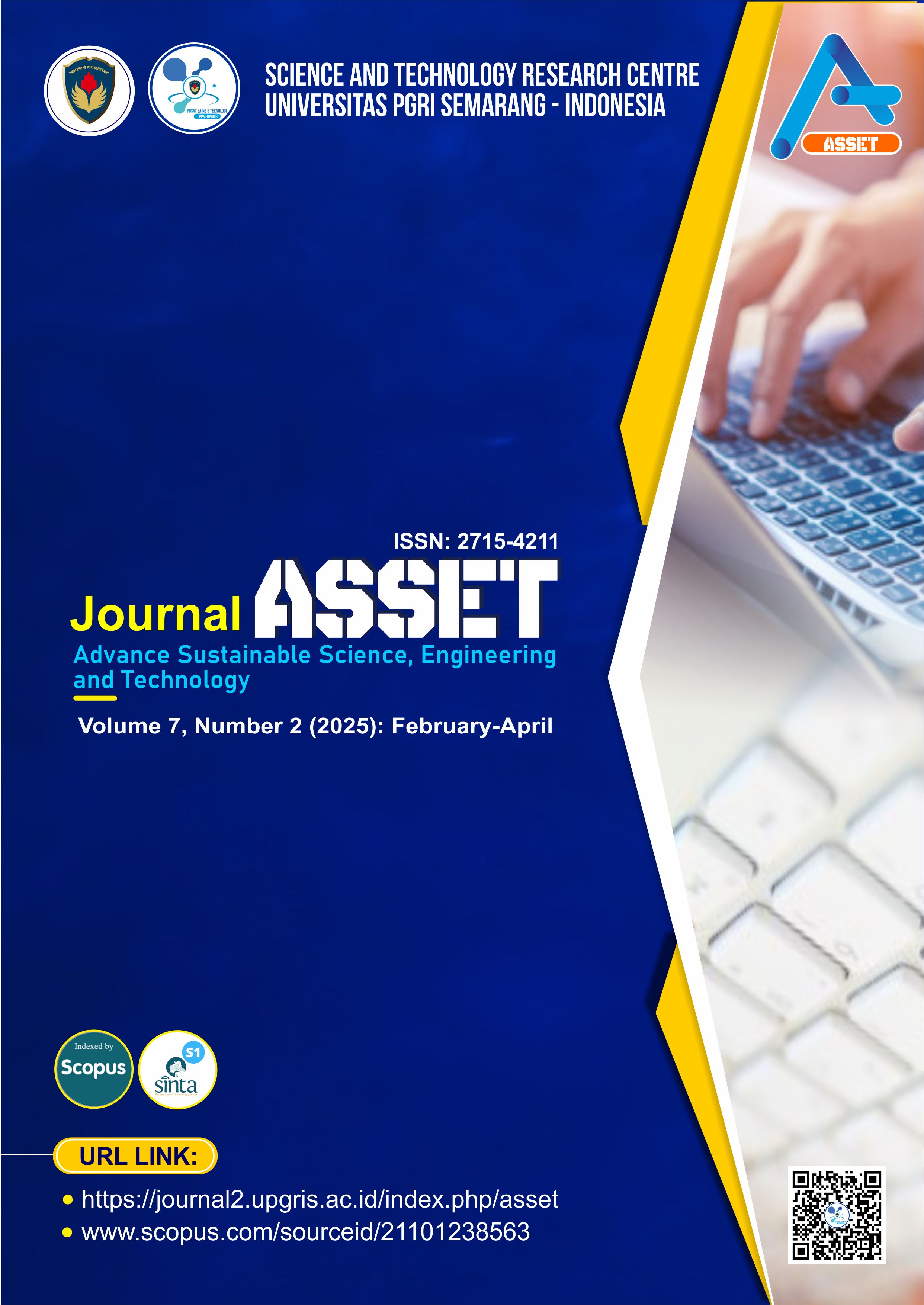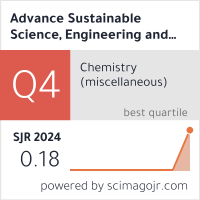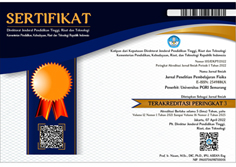Kinetic and Equilibrium Study of Synthetic Dye Adsorption Using Alkali-Activated Scallop Shells as Sustainable Adsorbents
DOI:
https://doi.org/10.26877/2nbjnr75Keywords:
adsorption, equilibrium studies, kinetic analysis, Pink IR dyes, scallop shell, synthetic textile dyesAbstract
Scallop shells are abundant in Indonesia, particularly along the northern coast of Java Island in Pekalongan Regency. These shells serve as natural adsorbents for removing synthetic textile dyes from aqueous solutions due to their high mineral content, especially calcium carbonate. Adsorption experiments were conducted to evaluate the potential of scallop shells as adsorbents for removing vat dye solutions. Adsorption kinetics were analyzed using pseudo-first-order and pseudo-second-order models in both linear and non-linear forms. The results showed that the non-linear pseudo-first-order model best described the adsorption process, with a qe value of 0.98982 mg/g. Equilibrium studies using Langmuir, Freundlich, and Jovanovic isotherm models indicated that the linear Freundlich model provided the best fit, with an R² of 0.99969, suggesting a heterogeneous adsorption process. These findings confirm that scallop shells are effective and eco-friendly adsorbents for textile dye removal and hold promise for sustainable water treatment. Further studies are suggested under real industrial conditions.
References
[1] M. S. Sihotang, D. Aisyah, dan S. Wahyuni, “Utilization of scallop shells (Placuna placenta) for potential water filter prototype in Jaring Halus Village, Jaring Halus-Langkat District and the characterization test,” J. Technomaterial Phys., vol. 4, no. 1, hal. 18–23, 2022, doi: 10.32734/jotp.v4i1.7395.
[2] J. Sawai, “Antimicrobial characteristics of heated scallop shell powder and its application,” Biocontrol Sci., vol. 16, no. 3, hal. 95–102, 2011, doi: 10.4265/bio.16.95.
[3] F. Pricop, I. C. Moga, dan A. Popescu, “Eco-friendly solutions for pollution prevention and textile wastewater treatment,” in ICAMS Proceedings of the International Conference on Advanced Materials and Systems, 2016, hal. 1–6. doi: 10.24264/icams-2016.iv.12.
[4] A. Juliani, S. Rahmawati, dan M. Yoneda, “Heavy metal characteristics of wastewater from batik industry in Yogyakarta area, Indonesia,” Int. J. GEOMATE, vol. 20, no. 80, hal. 59–67, 2021, doi: 10.21660/2021.80.6271.
[5] A. Buasri, N. Chaiyut, V. Loryuenyong, P. Worawanitchaphong, dan S. Trongyong, “Calcium oxide derived from waste shells of mussel, cockle, and scallop as the heterogeneous catalyst for biodiesel production,” Sci. World J., vol. 2013, hal. 1–7, 2013, doi: 10.1155/2013/460923.
[6] S. H. Park, S. H. Park, A. Koutsospyros, dan D. H. Moon, “Effects of scallop shells and starfish (Asterias amurensis) on stabilization of metalloid (As) and heavy metal (Pb and Zn)-contaminated soil,” Agronomy, vol. 14, no. 8, hal. 1–19, 2024, doi: 10.3390/agronomy14081781.
[7] T. Chenet et al., “Scallop shells as biosorbents for water remediation from heavy metals: Contributions and mechanism of shell components in the adsorption of cadmium from aqueous matrix,” Heliyon, vol. 10, no. 7, hal. 1–16, 2024, doi: 10.1016/j.heliyon.2024.e29296.
[8] F. Mihara et al., “Removal of strontium from aqueous solutions using scallop shell powder,” J. Ceram. Soc. Japan, vol. 127, no. 2, hal. 111–116, 2019, doi: 10.2109/jcersj2.18156.
[9] A. Mohagheghian, R. Vahidi-Kolur, M. Pourmohseni, J. K. Yang, dan M. Shirzad-Siboni, “Application of scallop shell-Fe3O4 nanoparticles for the removal of Cr(VI) from aqueous solutions,” Water Sci. Technol., vol. 75, no. 10, hal. 2369–2380, 2017, doi: 10.2166/wst.2017.120.
[10] M. Usuda et al., “Inhibitory effect of adsorption of Streptococcus mutans onto scallop-derived hydroxyapatite,” Int. J. Mol. Sci., vol. 24, no. 14, hal. 1–17, 2023, doi: 10.3390/ijms241411371.
[11] A. F. Hassan dan R. Hrdina, “Chitosan/nanohydroxyapatite composite based scallop shells as an efficient adsorbent for mercuric ions: Static and dynamic adsorption studies,” Int. J. Biol. Macromol., vol. 109, hal. 507–516, 2018, doi: 10.1016/j.ijbiomac.2017.12.094.
[12] W. A. Shaltout, G. A. El-Naggar, G. Esmail, dan A. F. Hassan, “Synthesis and characterization of ferric@nanocellulose/nanohydroxyapatite bio-composite based on sea scallop shells and cotton stalks: adsorption of Safranin-O dye,” Biomass Convers. Biorefinery, vol. 14, no. 4, hal. 4759–4776, 2024, doi: 10.1007/s13399-022-02753-1.
[13] R. S. Dewi, R. S. Kasiamdari, E. Martani, dan Y. A. Purwestri, “Mechanisms of Indigosol Blue O4B batik dye wastewater degradation by Aspergillus sp. 3 and its product analysis,” Res. J. Biotechnol., vol. 16, no. 2, hal. 34–42, 2021.
[14] Y. L. Ni’Mah, I. Sulistyani, S. Suprapto, dan K. S. Dewi, “Absorption of indigosol dye waste from batik home industry at ex redlight district, Dolly, Surabaya using activated carbon,” in IOP Conference Series: Materials Science and Engineering, 2019, hal. 1–8. doi: 10.1088/1757-899X/588/1/012044.
[15] K. Dadras, S. D. Ashrafi, K. Taghavi, dan J. Jaafari, “Evaluating the efficiency of scallop shell/iron oxide(II) nanocomposite in removal of Direct red 81 dye from aqueous solutions: kinetic, isotherm and thermodynamic studies,” Desalin. Water Treat., vol. 289, hal. 238–247, 2023, doi: 10.5004/dwt.2023.29374.
[16] A. Mohagheghian, R. Vahidi-Kolur, M. Pourmohseni, J. K. Yang, dan M. Shirzad-Siboni, “Preparation and characterization of scallop shell coated with Fe3O4 nanoparticles for the removal of azo dye: Kinetic, equilibrium and thermodynamic studies,” Indian J. Chem. Technol., vol. 25, no. 1, hal. 40–50, 2018, doi: 10.56042/ijct.v25i1.11605.
[17] P. Z. Sore et al., “Removal of contaminants in water with scallop shell waste,” Appl. Sci., vol. 14, no. 8, hal. 1–18, 2024, doi: 10.3390/app14083499.
[18] M. N. Haris, R. Ratnawati, dan N. Aryanti, “Effect of acid and alkaline treatment on the adsorption capacity of cuttlefish bone,” World J. Adv. Eng. Technol. Sci., vol. 9, no. 1, hal. 316–320, 2023, doi: 10.30574/wjaets.2023.9.1.0177.
[19] M. Dehvari, M. H. Ehrampoush, dan M. T. Ghaneian, “Adsorption kinetics and equilibrium studies of reactive red 198 dye by cuttlefish bone powder,” Iran. J. Chem. Chem. Eng., vol. 36, no. 2, hal. 143–151, 2017.
[20] K. Kaharuddin, M. Edihar, dan S. Suhardin, “Synthesis and Characterization Materials Modern (CMC-Fe3O4-Chitosan-TiO2) As Portable Adsorbent Toxic Metal (Hg) and Dye Substance (Rh B),” Adv. Sustain. Sci. Eng. Technol., vol. 6, no. 3, hal. 02403018, 2024, doi: 10.26877/asset.v6i3.709.
[21] S. D. Rahayu, R. M. D. Ujianti, dan F. Nurdyansyah, “Physicochemical Characteristics of Catfish (Clarias sp) Sausage with Addition of Moringa Leaf Flour (Moringa oleifera),” Adv. Sustain. Sci. Eng. Technol., vol. 4, no. 1, hal. 0220107, 2022, doi: 10.26877/asset.v4i1.11878.
[22] C. He et al., “Nutrient comparisons among the noble scallops Chlamys nobilis with three different shell colours to provide advices for consumers to choose high-quality food,” Front. Mar. Sci., vol. 11, hal. 1–8, 2024, doi: 10.3389/fmars.2024.1395339.
[23] M. S. Jeong, J. S. Park, S. H. Song, dan S. B. Jang, “Characterization of antibacterial nanoparticles from the scallop, Ptinopecten yessoensis,” Biosci. Biotechnol. Biochem., vol. 71, no. 9, hal. 2242–2247, 2007, doi: 10.1271/bbb.70228.
[24] A. Izza, T. Kojima, Y. Amano, dan M. Machida, “Calcined scallop shells for phosphate adsorption in aqueous solution,” J. Environ. Chem., vol. 30, hal. 119–124, 2020, doi: 10.5985/jec.30.119.
[25] W. Mao, G. Akimitsu, dan H. Ren, “Study on a simple method removing Cd from scallop processing waste,” Int. J. Food Eng., vol. 4, no. 1, hal. 32–35, 2018, doi: 10.18178/ijfe.4.1.32-35.
[26] M. Shirzad-Siboni, A. Khataee, dan S. W. Joo, “Kinetics and equilibrium studies of removal of an azo dye from aqueous solution by adsorption onto scallop,” J. Ind. Eng. Chem., vol. 20, no. 2, hal. 610–615, 2014, doi: 10.1016/j.jiec.2013.05.023.
[27] H. Yazid et al., “Removal of Congo Red from Aqueous Solution Using Cuttlefish Bone Powder,” Phys. Chem. Res., vol. 9, no. 4, hal. 565–577, 2021, doi: 10.22036/pcr.2021.278943.1901.
[28] S. Bhagyaraj, M. A. Al-Ghouti, M. Khan, P. Kasak, dan I. Krupa, “Modified os sepiae of Sepiella inermis as a low cost, sustainable, bio-based adsorbent for the effective remediation of boron from aqueous solution,” Environ. Sci. Pollut. Res., vol. 29, hal. 71014–71032, 2022, doi: 10.1007/s11356-022-20578-3.











